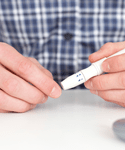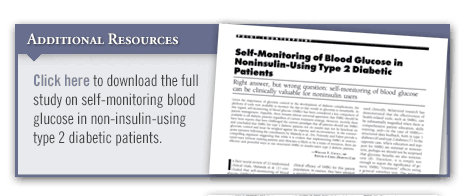Achieving glycemic control is paramount to helping patients prevent the development of diabetes-related complications. According to William H. Polonsky, PhD, CDE, several tools are available to monitor the day-to-day trends in glycemia, one of the most important of which has been self-monitoring of blood glucose (SMBG). “SMBG has been considered a key component of patient management,” he says. “There remains widespread agreement that SMBG should be available to all patients with diabetes regardless of their current treatment strategy.”
In Diabetes Care, Dr. Polonsky and colleagues had a study published showing that appropriate use of structured SMBG significantly improves glycemic control in insulin-naïve patients with type 2 diabetes (Table 1). The analysis also revealed that structured SMBG facilitated more timely and aggressive treatment changes without decreasing general well-being. Despite these findings, a number of other recent reports have challenged the notion that all patients should use SMBG because it may have little impact on glycemic control.
Structure Matters
Implementing SMBG in unstructured ways without training patients and clinicians is likely to be a waste of resources. However, the findings of recent studies that have challenged SMBG use do not mean that this monitoring strategy should be eliminated from clinical use. “Like any good tool, SMBG may be used well or poorly,” says Dr. Polonsky. “Unlike a medication, SMBG is not uniformly administered across all patients and settings.” SMBG varies considerably by the clinical question it addresses and the recommended frequency and timing of tests. The expertise of patients regarding its use and the involvement and knowledge of clinicians in interpreting and responding to SMBG data are other important factors.
Dr. Polonsky says there are effective and powerful ways to use structured SMBG in insulin-naïve patients. “Clinicians must weigh the expenses and inconvenience of SMBG,” he says. “Behavioral research has shown that the effectiveness of SMBG can be substantially magnified when there is comprehensive patient education, skills training, and structured data feedback.”
Frequency & Timing
According to Dr. Polonsky, the recommended frequency and timing of SMBG must be adequate, but this step will vary depending on the clinical concern addressed (Table 2). “The goal of using SMBG may be to assure that clinicians have the data they need to propose timely medication adjustments or lifestyle recommendations,” he says. “Or, the goal may be to alert patients that dietary or activity changes are needed.” He recommends that highly structured SMBG be used before and after selected meals or before and after exercise repeatedly over several days if the purpose is to collect adequate data on blood glucose patterns and use them as the basis for corrective action.
Patient & Clinician Considerations
It is imperative that patients know why they are using SMBG, what the data mean, and what they can do with the results. “It’s challenging to know how much patients understand about SMBG and what they actually do with the data,” says Dr. Polonsky. “SMBG education and support can vary widely. We must ensure that patients truly understand and can respond to SMBG data appropriately or patients may become less motivated to continue this monitoring over time.”
An important value of SMBG is that it can provide clinicians with the information they need to make timely treatment adjustments. Clinician involvement in SMBG can also help patients see that their efforts are worthwhile, thus enhancing motivation to continue SMBG over time. “SMBG is more likely to be beneficial when clinicians review SMBG data with patients, put the data to use, and work directly with patients in a close and collaborative manner,” Dr. Polonsky says. “This requires using carefully constructed, easy-to-read tools and forms that make sense to both patients and clinicians and are tailored to address specific clinical questions.”
Looking Forward
Given the financial restrictions facing healthcare and the potential positive impact of SMBG on glycemic control, it is important to carefully evaluate the clinical effectiveness of SMBG for insulin-naïve patients with type 2 diabetes. “Now is the time to direct resources to discovering the best means for effectively using structured SMBG,” says Dr. Polonsky. “In the future, it’s hoped that more comprehensive analyses of existing trials will be conducted and that clinicians will factor in effective and powerful ways to use structured SMBG in insulin-naïve patients more precisely. The goal should be to appropriately maximize the use of SMBG data and develop systems that facilitate the implementation of SMBG as a standard component of patient care.”




 admin
admin